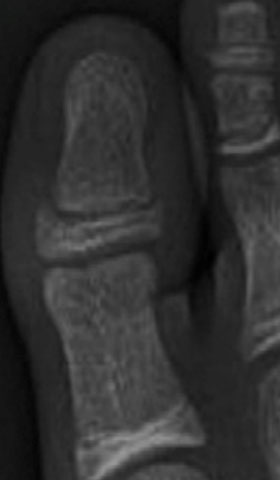

The lesser toes are not as important, anatomically.

Otherwise, minimal involvement of the first MTP joint can be managed with a CAM walker for three weeks, followed by a rigid post-op shoe. Displaced fracture fragment requires open fixation.

Luckily, most patients can compensate and adapt to some stiffness in this joint if the remainder of the foot has normal mobility. Due to the crush mechanism of injury, the clinician should check carefully for nailbed lacerations and a subungual hematoma.įractures that extend into the first metatarsophalangeal (MTP) joint space will often lead to chronic stiffness of the MTP joint. These should be immobilized with a CAM walker-a high-top walking boot-for two to three weeks before converting to a rigid shoe.īecause of their anatomic importance, displaced frac- tures of the proximal phalanx need to be fixed with a K wire and should be referred to orthopedics or podiatry. However, transverse frac- tures through the proximal phalanx are more trouble- some. The strong flexor tendons on the plantar surface of the toe may cause the fracture to displace and lead to chronic deformities and shoe-fitting problems if not fixed properly.Ī simple, nondisplaced fracture of the distal phalanx can be treated with buddy taping of the toes for two to three weeks and a post-op shoe. The first ray is essential to proper ambulation, especially during toe push off.įractures of the hallux commonly occur from a direct blow to the foot. The great toe, or hallux, and its metatarsal are anatom ically distinct from the rest of the forefoot and are designated as the first ray. In this first installment, we will discuss fractures of the toes, meta tarsals, and Lisfranc joint (tarsal-metatarsal joints) the second will appear in the January issue of JUCM and focus on injuries, particularly fractures, to the cuboid, cuneiforms, navicular, talus, Chopart joint, and calcaneus, as well as compartment syndrome. Our examination of foot fractures in urgent care will be divided into two parts. For example, young families in suburban areas are more likely to present with forefoot fractures and stress fractures in more urban or industrial environs, urgent care clinicians are more likely to see injuries resulting from motor vehicle accidents or high-energy trauma leading to fractures and dislocations of the more rigid midfoot and hindfoot. The scope of foot fractures seen in the urgent care setting varies by locale and demographics of the patient population. The role of the urgent care clinician in patients with other significant fractures, the vast majority of whom will need to be referred to orthopedics for definitive care this will include pitfalls to avoid in the acute assessment and management of these patients. Proper management of and follow-up for simple nondisplaced fractures in the foot.Ģ. This article will focus primarily on two aspects of care:ġ. Understanding the natural history of untreated fractures in the foot is imperative to positive outcomes. Your health care provider might refer you to a specialist in orthopedic surgery.Urgent message: Acute injuries to the foot often send patients to an urgent care center-though on occasion they don’t present for weeks, or even months, after the injury occurred. Use it for about 15 minutes at a time, taking a break of at least 20 minutes before icing again. If you use ice, wrap it in a towel so that it doesn't touch your skin. Prop your foot up when possible so that your injury is higher than your heart. Raising the foot and using ice can help reduce swelling and pain. In some cases, a surgeon may need to use pins, plates or screws to keep the bones in place during healing. If the pieces of the broken toe won't stay snugly together, a walking cast might help. This can prevent the toe from moving and provide more room for swelling. A care provider might prescribe a post-surgical shoe that has a stiff bottom and a soft top that closes with strips of fabric.
Non displaced toe fracture skin#
Putting gauze or felt between the toes before taping can prevent skin soreness. For a simple fracture in any of the smaller toes, taping the injured toe to one next to it might be all that's needed. To heal, a broken bone must not move so that its ends can knit back together. Ice or a shot of anesthetic numbs the toe. It's usually done without cutting the skin. If the broken pieces of the bone don't fit snugly together, a care provider might need to move the pieces back into place. Severe pain might require prescription painkillers. You can usually manage pain from a broken toe with medicines such as ibuprofen (Advil, Motrin IB, others), naproxen sodium (Aleve) or acetaminophen (Tylenol, others) that you can get without a prescription.


 0 kommentar(er)
0 kommentar(er)
